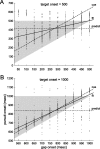Anticipatory movement timing using prediction and external cues
- PMID: 16641231
- PMCID: PMC6674054
- DOI: 10.1523/JNEUROSCI.3739-05.2006
Anticipatory movement timing using prediction and external cues
Abstract
Animals often make anticipatory movements to compensate for slow reaction times. Anticipatory movements can be timed using external, sensory cues, or by an internal prediction of when an event will occur. However, it is unknown whether external or internal cues dominate the anticipatory response when both are present. Smooth pursuit eye movements are generated by a motor system heavily influenced by anticipation. We measured pursuit to determine how its timing was influenced when both a predictable event and a visual cue were present. Monkeys tracked a moving target that appeared at a constant time relative to the onset of a fixation point. At a randomized time before target onset, the fixation point disappeared, creating a temporal "gap" that cued impending target motion. We found that the gap onset cue and prediction of target onset together determined pursuit initiation time. We also investigated whether prediction could override the gap onset cue or vice versa by manipulating target onset and, hence, the duration of time that the animal had to estimate to predict it. When target motion began earlier, the pursuit system relied more on prediction to trigger a movement, whereas the cue was more often used when the target moved later. Pursuit latency in previous trials partially accounted for this behavior. The results suggest that neither internal nor external factors dominate to control the anticipatory response and that the relative contributions vary with stimulus conditions. A model in which neuronal anticipation and fixation signals interact can explain the results.
Figures









References
-
- Barnes GR, Donelan SF (1999). The remembered pursuit task: evidence for segregation of timing and velocity storage in predictive oculomotor control. Exp Brain Res 129:57–67. - PubMed
-
- Boman DK, Hotson JR (1988). Stimulus conditions that enhance anticipatory slow eye movements. Vision Res 28:1157–1165. - PubMed
-
- Bon L, Lucchetti C (1991). Behavioral and motor mechanisms of dorsomedial frontal cortex of macaca monkey. Int J Neurosci 60:187–193. - PubMed
-
- Carl JR, Gellman RS (1987). Human smooth pursuit: stimulus dependent responses. J Neurophysiol 57:1446–1463. - PubMed
Publication types
MeSH terms
Grants and funding
LinkOut - more resources
Full Text Sources
Miscellaneous
